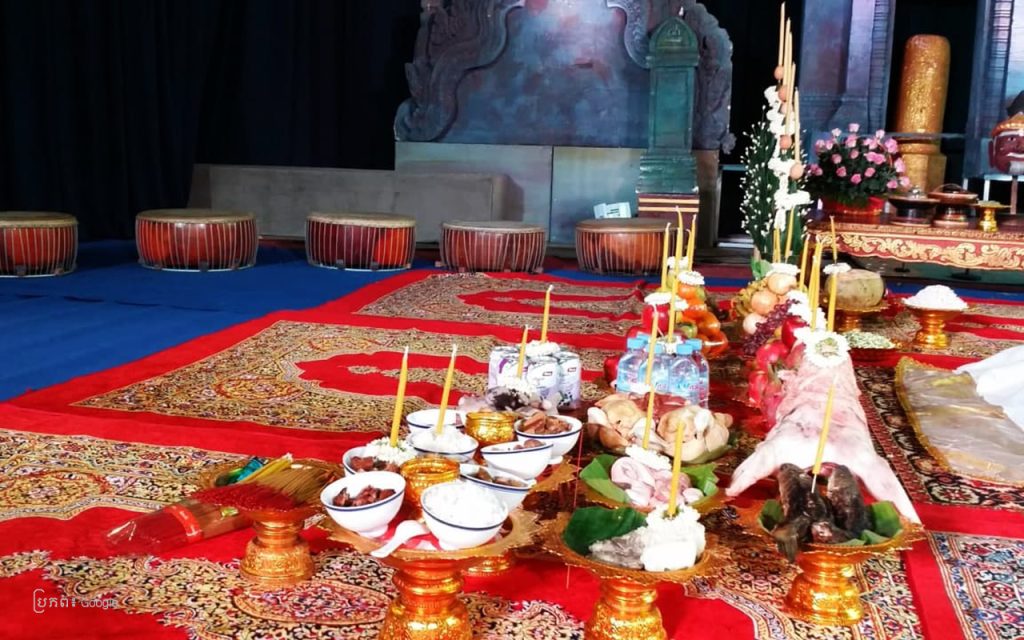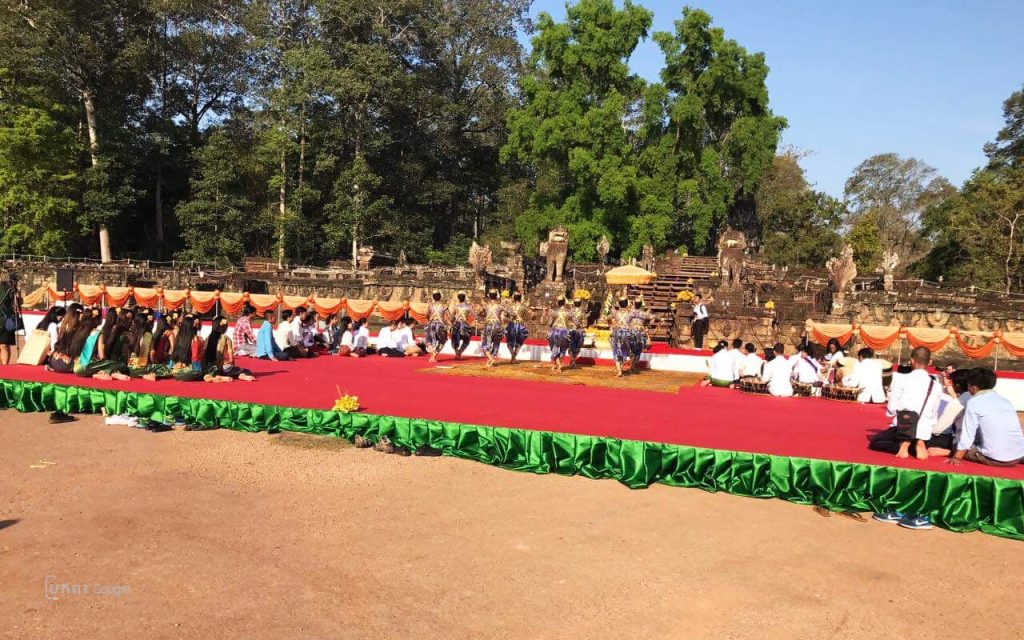សាសនានិងសិល្បៈ ជានិច្ចកាល គឺនៅជាប់នឹងជីវិតរបស់ខ្មែរ និងមានតួនាទីសំខាន់ ព្រមទាំងជាចលករធ្វើឱ្យអរិយធម៌ខ្មែរអភិវឌ្ឍឬឱនថយ។ នៅក្នុងអត្ថបទនេះ ខ្ញុំនឹងបកស្រាយអំពីគំនិតនិងស្ថានភាព ដែលសាសនាប្រើសិល្បៈជាមធ្យោបាយ ដើម្បីបង្ហាញអំពីជំនឿនិងទំនៀមទម្លាប់មូលដ្ឋាននៅក្នុងប្រទេសកម្ពុជា។ ខ្ញុំក៏នឹងពិនិត្យមើលតួនាទីរបស់តន្ត្រី របាំ និងអក្សរសិល្ប៍នៅក្នុងប្រពៃណីព្រះពុទ្ធសាសនា ជារូបភាពសិល្បៈនិងអត្ថន័យអប់រំ ក៏ដូចជាឥទ្ធិពលនៃសាសនានិងសិល្បៈទៅលើវប្បធម៌បច្ចុប្បន្ននៃប្រទេសកម្ពុជា។
ការរួមបញ្ចូលគ្នានូវជំនៀអរូបី ព្រហ្មញ្ញសាសនា ហ៊ិនឌូសាសនា និងព្រះពុទ្ធសាសនា បានបង្កប់នៅក្នុងជំនឿរបស់ខ្មែររាប់រយពាន់ឆ្នាំមកហើយ។ ប្រវត្តិសាស្ត្រខ្មែរ បានបង្ហាញថា ពីដើមឡើយ ខ្មែរយើងអនុវត្តជំនឿអរូបី ហើយក្រោយមកទៀត ទើបសាសនាឯទៀតៗត្រូវបានឧទ្ទេសនាមនិងមានវត្តមាននៅកម្ពុជា។ ក្នុងន័យនេះ ខ្មែរយើងមិនបានចាប់យកសាសនាដែលទើបនឹងហូរចូលមកថ្មី ហើយបោះបង់ជំនឿនិងសាសនាចាស់នោះឡើយ ពោលគឺយើងរក្សា និងបដិបត្តិជំនឿនិងសាសនាដែលមានទាំងអស់រួមគ្នា។
ដោយឡែក យើងឃើញថា សាសនានិងសិល្បៈ មានទំនាក់ទំនងនិងពាក់ព័ន្ធនឹងគ្នា។ សាសនា មានឥទ្ធិពលខ្លាំងក្លាទៅលើសិល្បៈ ជាពិសេស ស្ថាបត្យកម្ម ចម្លាក់ អក្សរសិល្ប៍ និងរបាំ។ សិលាចារឹក បានបង្ហាញថា ព្រះមហាក្សត្រខ្មែរ បានឧទ្ទិសស្រីរបាំដល់អាទិទេពនិងបុព្វបុរសរបស់ព្រះអង្គ។ ដូច្នេះហើយបានជាយើងឃើញនៅលើប្រាសាទបុរាណនាសម័យអង្គរ មានស្រីរាំ តន្ត្រីករ និងតន្ត្រីការិនីជាច្រើន។ ឯកសាររបាំ បានបញ្ជាក់ថារបាំទាំងឡាយមិនមែនគ្រាន់តែជាទស្សនីយភាពសម្រាប់តែការកម្សាន្តតែប៉ុណ្ណោះទេ តែថែមទាំងជាការបូជាសំខាន់ចំពោះព្រលឹងនៃអាទិទេពនិងបុព្វបុរស ដើម្បីសេចក្តីសុខនិងសេចក្តីចម្រើន។ នាបច្ចុប្បន្ន ការអនុវត្តជំនឿបុរាណក៏នៅមាននិងថែរក្សា ដូចជាការថ្វាយភ្លេងពិណពាទ្យ ព្រមទាំងដង្វាយផ្សេងៗជាដើម។
តន្ត្រី កំដរជីវិតរបស់ខ្មែរគ្រប់រូប ចាប់តាំងពីនៅក្នុងអង្រឹង ពោលគឺម្តាយបំពេកូនដោយបង្កប់នូវអត្ថន័យខ្លឹមសារនៃដំបូន្មានសីលធម៌បុរាណ។ ពិធីផ្សេងៗ ពីខួបកំណើត ពិធីកោរសក់ (កោរជុក) ចូលម្លប់ បំបួសនាគ អាពាហ៍ពិពាហ៍ និងជំងឺ រហូតដល់ពិធីបុណ្យសព ដែលប្រារព្វឡើង គឹមិនគ្រប់គ្រាន់ពេញលេញឡើយ ប្រសិនបើគ្មានតន្ត្រីអមផង។ ពិធីបុណ្យជាតិនិងសាសនា ដូចជាចូលឆ្នាំ ភ្ជុំបិណ្ឌ សំពះគ្រូ និងអារក្ស ក៏តម្រូវឱ្យមានតន្ត្រីកំដរ។ លើសពីនេះទៅទៀត តន្ត្រីមានតួនាទីសំខាន់ក្នុងការកំដរសិល្បៈទស្សនីយភាព មានល្ខោននិងរបាំជាដើម។
ក្នុងរបាំ អ្នករាំរៀបចំធ្វើពិធីសំពះគ្រូ (ខ្នាតតូច) ដើម្បីបួងសួងសូមពរជ័យដល់ការសិក្សារៀនសូត្រសិល្បៈរបាំ មុននឹងចាប់មេរៀនទី១របស់គេ។ ពិធីនេះសំខាន់ណាស់ ដែលអ្នករាំគ្រប់គ្នាប្រារព្វធ្វើហើយធ្វើទៀតនៅក្នុងឆាកជីវិតរបស់គេ ជាអ្នករាំ ដោយគេមានជំនៀថា សម្តេចព្រះគ្រូ ដែលស្ថិតនៅក្នុងរបាំ នឹងតាមថែរក្សាគេនិងជូនពរជ័យដល់ការសិក្សារបស់គេ។
របាំព្រះរាជទ្រព្យ ឬ របាំក្បាច់បុរាណខ្មែរ ស្ថិតនៅជាប់ក្នុងព្រះបរមរាជវាំងខ្មែរជាងមួយពាន់ឆ្នាំមកហើយ និងមានប្រភពដើមចេញពីពិធីសក្ការៈនិងការបូជាឧទ្ទិសចំពោះបុព្វបុរស ដូច្នេះគេចាត់ទុកថាជា «របាំសក្ការៈ»។
នៅលើជញ្ជាំងប្រាសាទបុរាណនានាក្នុងព្រះរាជាណាចក្រកម្ពុជា គេឃើញមានរូបចម្លាក់អប្សរាចំនួន ១,៧៨៧ ដែលបញ្ជាក់និងឆ្លុះបញ្ចាំងពីយុគសម័យដ៏រុងរឿងរបស់ខ្មែរ ដែលសិល្បៈទស្សនីយភាពមានភាពលូតលាស់ដល់កំពូល។ ស្រីរាំទេពអប្សរទាំងនេះ មានតួនាទីជាស្ពានបន្តភ្ជាប់ពីអាទិទេពមកមនុស្ស ដែលគេចាត់ទុកថាជា «ស្រីរាំសក្ការៈ» មានតួនាទីរាំដើម្បីបំពេញព្រះទ័យអាទិទេពនិងព្រលឹងរបស់បុព្វបុរស។
សាសនា ជាមូលដ្ឋានគ្រឹះនៃសង្គមខ្មែរ។ ព្រះពុទ្ធសាសនា ជាពិសេសការអប់រំ មានឥទ្ធិពលមកលើគំនិតនិងចរិតលក្ខណៈរបស់ខ្មែរ។ ជីវិតខ្មែរដែលគ្មានព្រះពុទ្ធសាសនា ជាជីវិតដែលគ្មានប្រពៃណី វប្បធម៌ និងអត្តសញ្ញាណ។ អវត្តមានព្រះពុទ្ធសាសនា ប្រៀបដូចជាការបំបែកនូវធាតុស្នូលនៃសង្គមនិងការរួបរួមសាមគ្គីសហគមន៍ ក៏ដូចជាជីវិតរស់នៅប្រចាំថ្ងៃរបស់ខ្មែរ។ ដោយឡែក ខ្មែរយើងគិតថា អវត្តមានព្រះពុទ្ធសាសនា ក៏ដូចជាការបាត់បង់ភាពជាខ្មែរដូច្នោះដែរ។
យើងមានពាក្យស្លោកមួយឃ្លាថា «សាសនានិងសិល្បៈជាកញ្ចក់ឆ្លុះសង្គម»។ ប្រសិនបើនេះជាការពិត ព្រះពុទ្ធសាសនានិងសិល្បៈប្រាកដជាកញ្ចក់ឆ្លុះសង្គមខ្មែរ និងជាមូលដ្ឋាននៃវប្បធម៌ខ្មែរ។ ឧទាហរណ៍ ប្រាសាទអង្គរវត្ត ជាមោទកភាពនៃនិមិត្តសញ្ញាជាតិខ្មែរ សម្រាប់ខ្មែរគ្រប់ទំនោរ និន្នាការ ជាតិពន្ធុ កុម្មុយនីស្ត សង្គមនិយម សាធារណរដ្ឋនិយម ក៏ដូចជារាជានិយម។ ប្រាសាទអង្គរវត្ត មាននៅលើទង់ជាតិនៃរបបទាំងអស់ខាងលើនេះ។ លើសពីនេះទៅទៀត ខ្មែរយើងគ្រប់គ្នាយល់ថា របាំព្រះរាជទ្រព្យខ្មែរ ជានិមិត្តរូបនៃមោទនភាពនិងអត្តសញ្ញាណជាតិខ្មែរ។
នៅក្នុងបរិបទលូតលាស់ជឿនលឿននៃវិទ្យាសាស្ត្រ បច្ចេកវិទ្យា និងបញ្ញាសិប្បនិមិ្មត ជំពូកថ្មីមួយនឹងត្រូវសរសេរអំពីសាសនានិងសិល្បៈ ព្រមទាំងការសូនវប្បធម៌ខ្មែរ។ វាក៏ជាការប្រឈមមួយរវាងវប្បធម៌ប្រពៃណីនិងអត្តសញ្ញាណវប្បធម៌ នៅក្នុងដំណើរឆ្ពោះទៅមុខទៀត។ នេះជាទំនួលខុសត្រូវរបស់យើងបច្ចុប្បន្ននិងអ្នកជំនាន់ក្រោយជាអ្នកបន្តវេនដែលត្រូវអភិរក្ស ច្នៃប្រឌិត បណ្តុះបណ្តាល លើកស្ទួយ ការពារ និងថែរក្សាបន្តសម្បត្តិវប្បធម៌ដូនតាខ្មែរឱ្យគង់វង្ស លូតលាស់ និងរុងរឿង។ ការរីកចម្រើននិងវិវត្តន៍ ចាប់ផ្តើមពីការមើលត្រឡប់ទៅក្រោយ សិក្សា និងយល់ដឹងច្បាស់អំពីប្រពៃណីខ្មែរ។ បុរាណមិនយឺត ឯសម័យក៏មិនមែនបរទេសដែរ។ ទំនើបនិងទាន់សម័យ ក៏មិនមែនមានន័យថា យើងត្រូវតែបោះបង់ចោលប្រពៃណីឡើយ តែយើងត្រូវរកវិធីនិងមធ្យោបាយថ្មី ដើម្បីបកស្រាយនិងបង្ហាញអំពីប្រពៃណីចាស់ឱ្យមានភាពទំនើប រំភើប ទាក់ទាញ អស្ចារ្យ និងពាក់ព័ន្ធទៅនឹងជំនាន់ កាលៈទេសៈពេលវេលា និងទីកន្លែង៕
——————————————————————-
RELIGION AND THE ARTS
Religion and the arts have always been an inherent part of Khmer life and have played an important role in causing Khmer civilization to develop and decline as long as the history of Cambodia can be written and remembered. The question of whether culture plays a significant role in shaping human behavior or whether natural instincts are the controlling factors has long been intriguing to scholars.
In this article, I address ways in which religion has utilized the arts as a vehicle to give expression to its fundamental beliefs and customs in Cambodia. I also examine the roles of music, dance, and literature in the Buddhist tradition as an artistic expression and didactic impulse, while looking at how religion and the arts have their influence on the shaping of the contemporary culture of Cambodia.
A blend of Animism, Brahmanism, Hinduism, and Buddhism has been deeply embedded in the Khmer belief for millennia. The history of Cambodia has revealed that at the beginning, Khmer people practiced Animism. As time went by, other religions were introduced to Cambodia. However, the Khmer did not abandon altogether one religion and belief and come to grip with new ones.
Throughout Khmer history, religion and the arts are interconnected. Religion has many influences on Khmer arts, especially architecture, sculpture, literature, and dance. Epigraphy attests that Khmer kings offered dancers in dedication to gods or their ancestors. Consequently, there are evidences that at Angkor Vatt, there were scores of female dancers and musicians (Thierry 1963: 361, Sam 1988: 231-232, Sam 1997: 13-14).
Dance accounts have revealed that dance was presented not for mere entertainment, but it was a significant offering object to the spirits for happiness and bliss. Today, some of the old practices are still preserved and performed by offering, for instance, the pinn peat ensemble along with other offering objects.
Music accompanies every Khmer as far back as his cradle. The sweet voices of our mothers lull babies to sleep embedded with traditional morals. Ceremonies organized and conducted throughout one’s life would not be complete without music, starting with the birth blessing, hair shaving, entering the shade (rite of passage), ordination, wedding, and illness to the funeral. National and traditional ceremonies also ask for music, including worship of the spirit, New Year, Soul Day, ancestral worship, and the ceremony of paying homage to the spirit of the teacher. Besides the aforementioned ceremonies, music plays a very important role in the accompaniment of the performing arts, including dances and theaters.
In dance, going back to the very beginning of a dancer’s career, a ceremony called pithi sampeah krou or “ceremony of paying homage to the spirit of the teacher” precedes one’s first lesson (Chan Moly Sam 1987: 13). This ceremony is so important that a dancer performs it over and over again throughout her/his dancing career. The ceremony is believed to place a dancer under the safeguard of Samdech Preah Krou (the Spirit residing in the dance) who thus protects and blesses the apprenticeship.
Khmer court dance has been associated with the royal court of Cambodia for over a thousand years, originating in the sacred rituals of ancestral worship, and has thus been regarded as “sacred dance.” On the walls of the Angkor temples and beyond, 1,787 apsaras (celestial dancers) were carved, reflecting a period of history in which Khmer performing art reached its greatest expression (Cravath 2007: 13). These apsaras functioned as intermediaries between the gods and humans, consequently regarded as “sacred dancers,” whose function was solely to perform to soothe gods and the spirits of ancestors.
Religion is certainly the preeminent foundation of Khmer society. Buddhism, particularly its teaching, influences the Khmer thinking and personality of all walks of life. Living without Buddhism is living without tradition, culture, and identity. The absence of Buddhism causes the disintegration of the nucleus of the society, jeopardizing the community’s unity and paralyzing the Khmer way of life. To many Khmer, the absence of Buddhism is the absence of the Khmerness.
In Cambodia, there is a slogan: “Religion and the arts reflect the society.” If this is true then, Buddhism and the arts are precisely the mirrors reflecting the Khmer society. They are the foundation of culture. Angkor Vatt has been the proud national symbol for the Khmer across racial and political tendencies, be it mainstream or ethnic, communism, socialism, republican, or monarchy. It has appeared on every flag of every regime in Cambodia flying and waving proudly in Cambodia’s sky and beyond. Besides the Angkor Vatt Temple, Khmer court dance is nationally and racially perceived to be the symbol of Khmer national pride and identity. In the present context of advanced science, technology, and artificial intelligence (AI), a new chapter will be written on religion and the arts and the shaping of Khmer culture. It will be an interesting challenge for the traditional culture vis-à-vis the cultural identity and cultural continuity. In my opinion, it is the responsibility of the present and future generations to keep alive the culture of their forbearers. Progress and evolution begin by looking back and studying the traditions and understanding them well. Being traditional is not backward and being modern is not necessarily advanced or foreign. To be current, we do not have to break away from tradition, but to find contemporary ways to express it.
អត្ថបទដើម៖ បណ្ឌិត សំ សំអាង








